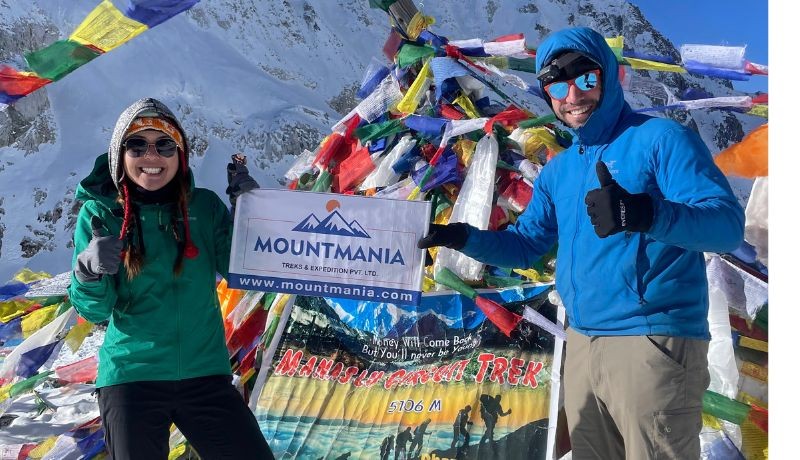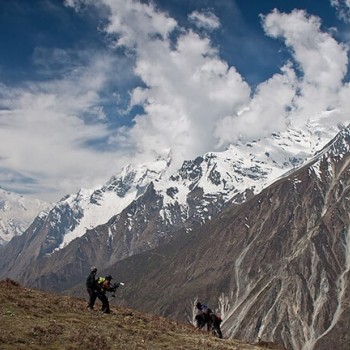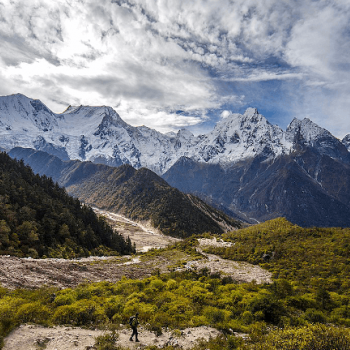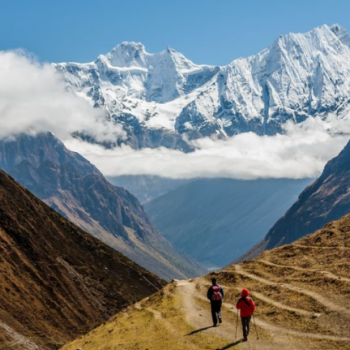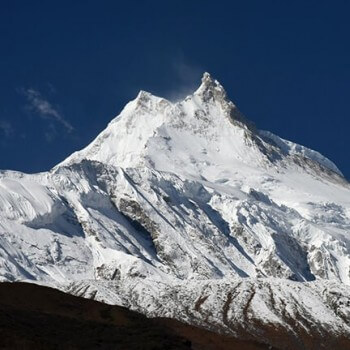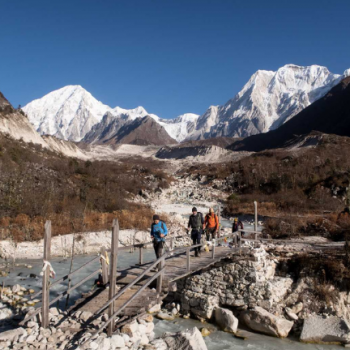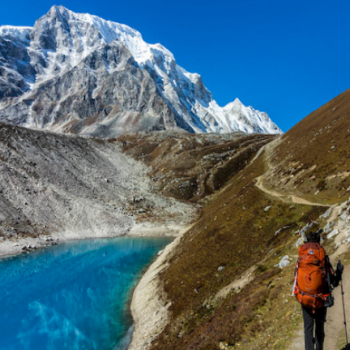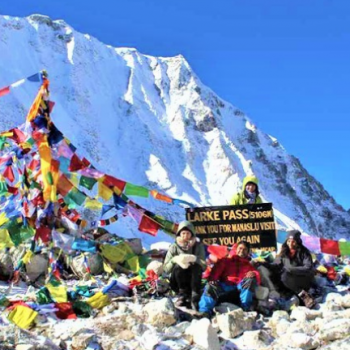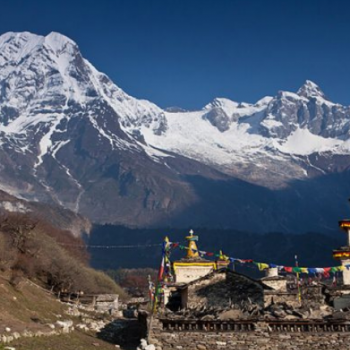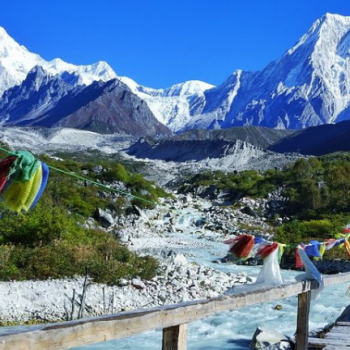Useful Information
Manaslu Circuit Trek Difficulty
The total length of the Manaslu Circuit trek is around 177 kilometers. You will be trekking for 9 days covering a distance of 15-20 kilometers every day.
Another factor that determines the difficulty of this trek is the uphills and downhills you will encounter along the way. Many times as you trek along the Budhi Gandaki river, the trek can be harrowingly steep. The trek up to Larkya La Pass is also quite challenging.
Guide on Manalsu Circuit Trek Difficulty
Manaslu Circuit Trek takes you to the highest altitude of 5,106 meters in Larkya La Pass. The altitude is high enough to incite altitude sickness. The trails also can get quite breezy making the trails quite cold.
Taking all of these things into consideration, the Manaslu Circuit Trek is a strenuous trek. As a result, you will have to be quite fit in order to complete this trek. 2-3 months of physical preparation will be necessary for you to complete this trek.
Manaslu Circuit Trek Best Time
Autumn (September, October, and November) is the most popular time for the Manaslu Circuit Trek. Autumn offers the most beautiful views of Manaslu as well as other mountains in the Annapurna Range.
Spring (March, April, and May) is the second most popular time for the Manaslu Circuit Trek. The rhododendron forests of the Manaslu Conservation Area light up beautifully in this season. The low rainfall in this season is another reason for the popularity of the spring season.
As you will trek to an altitude of more than 5000 meters in the Manaslu Circuit Trek, the trek can be quite cold in the winters (December, January, and February) with temperatures going as low as -20 degrees C. In the summer season (June, July, and August), the trails can be quite wet with the monsoon. So you will have to pack and prepare extremely well to trek in these two seasons.
FAQs
How can I obtain a visa for Nepal?
Getting a visa for Nepal is relatively straightforward. You can obtain a visa upon arrival at Tribhuvan International Airport in Kathmandu or at land border crossings. Alternatively, you can apply for a visa at a Nepalese embassy or consulate in your home country. Ensure you have a valid passport with at least six months of validity, a passport-sized photo, and the required visa fee in USD.
How challenging is the Manaslu Circuit Trek?
The Manaslu Circuit Trek is considered challenging, suitable for trekkers with good physical fitness and some trekking experience. The trek involves steep ascents and descents, high altitudes, and the crossing of the Larkya La Pass at 5,160 meters. Proper acclimatization and preparation are essential to handle the demands of this trek.
What services are included in the Manaslu Trekking package?
Trekking packages for the Manaslu Circuit typically include:
Airport transfers
PublicTransportation to and from the trailhead
Accommodation in tea houses during the trek
Meals during the trek (breakfast, lunch, and dinner)
Licensed trekking guide and porters
Necessary permits (Manaslu Restricted Area Permit, Manaslu Conservation Area Permit, and Annapurna Conservation Area Permit)
First aid kit
Is travel insurance required for trekking in the Manaslu Region?
Travel insurance is mandatory for the Manaslu Region Trek. The insurance should cover high-altitude trekking, emergency evacuation, medical expenses, and trip cancellation. Ensure your policy includes coverage for altitudes up to 6,000 meters.
Who will pick us up from the airport?
Our Mount Mania representative will meet you at Tribhuvan International Airport upon your arrival and transfer you to your hotel in Kathmandu.
What is the best time to trek to Manaslu?
The best times to trek the Manaslu Circuit are during the pre-monsoon (March to May) and post-monsoon (September to November) seasons. These periods offer stable weather conditions, clear skies, and excellent views of the mountains.
Is there internet service available during the Manaslu Circuit Trek?
Internet service is available in some tea houses along the Manaslu Circuit, but it can be slow and unreliable. It is advisable to inform your family and friends that communication may be intermittent during the trek.
Is it safe to drink running water on the Manaslu Trek?
You should not drink untreated running water on the Manaslu Trek. Bottled water is available, but it is recommended to use water purification tablets or filters to treat water from local sources to reduce plastic waste and ensure safe drinking water.
Can I use credit cards in the Manaslu Region?
No, you can't used credit card in the Manaslu Region. It is advisable to carry enough cash (Nepalese Rupees) to cover your expenses during the trek, as ATMs are scarce along the trail.
What is the highest peak in the Manaslu Region?
The highest peak in the Manaslu Region is Mount Manaslu, standing at 8,163 meters (26,781 feet). It is the eighth-highest mountain in the world.
Is Larkya La Pass very difficult for beginner trekkers?
The Larkya La Pass is one of the most challenging sections of the Manaslu Circuit Trek. It is difficult for beginner trekkers due to its high altitude and steep ascent. Adequate preparation, acclimatization, and physical fitness are crucial for crossing the pass safely.
Can I trek in the Manaslu Region alone?
Solo trekking in the Manaslu Region is not allowed. Trekkers must be accompanied by a licensed guide and be in a group of at least two people, excluding the guide. This regulation ensures safety and supports local tourism.
What is the cost of permits for the Manaslu Circuit Trek?
The cost of permits for the Manaslu Circuit Trek includes:
Manaslu Restricted Area Permit: USD 70 for the first seven days and USD 10 for each additional day (from September to November); USD 50 for the first seven days and USD 7 for each additional day (from December to August)
Manaslu Conservation Area Permit: USD 30 per person
Annapurna Conservation Area Permit: USD 30 per person
What is the highest altitude we will reach during the Manaslu Circuit Trek?
The highest point reached during the Manaslu Circuit Trek is the Larkya La Pass, which stands at 5,160 meters (16,929 feet). This altitude requires careful acclimatization and preparation to avoid altitude sickness and ensure a successful trek.
How should I apply for Manaslu Trekking Permit?
Manaslu Trekking permit must be applied through the professional trekking agency which must be legally registered under the Nepal government act. Contact us to apply fo Special permit.
Can I apply for Manaslu trek permit individually?
This is one of the most common questions that most of the trekkers’ ask. But, you can not apply individually for Manaslu trekking permit. Minimum of two trekkers is required to apply for Manaslu special permit from one of the professional trekking agency.
Note: If you are planning Manaslu Trek individually, contact us we will find out other trekkers to join.
Do we need a guide and porter for Manaslu trekking?
As we know, the Manaslu region is located in the restricted area, the Nepal government and concerned authorities have made compulsory to have one licensed holder professional guide. Whereas, taking porter is optional. Another major reason behind taking guide is for easy communicating with the local people in a village. The guide will also provide information about the authentic culture around Manaslu region.
What's the weather look like in Manalsu?
At the start of the trek the climate is subtropical. Overall you can expect somewhere between 10 to 25 Celsius throughout the year. However in the upper parts of the trek the temperature will fall to -20 or below in the winter.
Feel free to contact us, if you are a planning a trip to Manaslu Trek, we will help you to create a customized itinerary on your specified month and cost.

